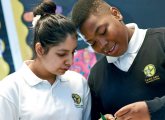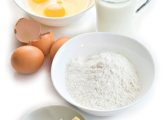Encourage students to look at themselves differently, as they explore Emma Delpech’s thoughtful and inspiring suggestions on the theme of the self-portrait…
The theme of self-portraiture is so endlessly versatile to the art teacher and it is relatively easy to engage students in the issues surrounding the idea of representing oneself in unconventional ways. Not quite the pasta-piece portrait of the budding 5-year-old artist, but something that employs deeper levels of understanding, psychology and self-reflection. The key element of this unit would be the potential for understanding the portrait within a range of contexts whereby the restrictions of photographic realism are absolutely removed. This enables students of all abilities to have full access to the top mark range. It connects on a very personal level with each student, exploring the dynamics of physical appearance, personality, self-respect, independence etc. My favourite element of this type of work is in studying aspiration, as well as what we feel makes us satisfied or happy and where we feel life is taking us. Abstraction, distortion, layering, humour; all of these can provide excellent learning tools and develop simplistic work to a much more mature and considered final outcome.
STARTER ACTIVITY
Provide a box of recycled materials (newspaper, masking tape etc). Ask students to create a ‘self-portrait’ using only the materials available. One might cut the outline of her head out of a sheet of newspaper, whilst another might want to make a three-dimensional paper sculpture, and a third will scrunch up a ball of paper and feel his work is done. It is the variety of outcomes that is essential to this activity and allows for interesting conversation to follow on: how and why does this work as a self-portrait? Does the scrunched up ball of paper, for example, actually tell us more about the artist because it reflects something of his instinctive response to the task – finding the path of least resistance and wanting simplicity – or does it reveal a lack of confidence with more challenging ways of working? How could such a simple concept be developed into something that gives the artist ownership and confidence in his project whilst potentially achieving a good grade? Perhaps the students will discuss developing this so that the ball of paper goes on a journey, is hung in interesting places, is dipped in multiple layers of substances and allowed to dry over a canvas onto which it drips as tough leaking/bleeding etc.
Photograph all outcomes for sketch books and set follow-up work to study the work of sculptors who work with paper such as Su Blackwell, Peter Callesen and Jennifer Khoshbin.
HOME LEARNING
Tasks could include:
researching relevant artists; considering themes and bringing in images from magazines or old photographs which students wish to use in their own work; producing self-portraits in drawn or photographic form; analysis of self-portraits chosen from the bank of artists; analysis of class work and developing themes.
MAIN ACTIVITIES
1. LAYERING OF PORTRAIT PHOTOGRAPHS IN PHOTOSHOP
Sometimes it is worth taking images of a student in which he/she stays in one spot but looks in multiple directions. Alternatively, use a DSLR camera on a slow shutter speed and allow the student to talk animatedly with lots of gesturing and movement (performing a short monologue is perfect for this and makes good connections with drama and performing arts). The images will be abstracted immediately and become even more interesting to work from.
If a dark room is available and the images have been inverted in Photoshop and printed onto standard copier paper, this can act as a negative and be used either as a photogram or chemigram with selective use of developing fluid on the undeveloped photographic paper. This works better in small groups.
2. DEVELOPING SCULPTURES BASED ON ARTIST RESEARCH
Biomechanoids make interesting imagery to combine with the self-portrait, adapting the image with elements of artificial and harsh mechanical subject matter. Cultural clothing, head dresses, costume and animal imagery can also be successful and make for interesting sculptural work. Once fired and glazed or painted these can become the subject of further photography. Some students would rather start with a found object such as a doll or piece of ceramic onto which they will draw/print/decoupage imagery from their research.
3. GROUP DISCUSSION
Examine the different outcomes of the group. Some may have become extremely exciting. Homework activities may have prompted some dynamic results. Share these amongst the group and explore the variety of ways students within the group have responded to the theme. What does this tell us about thinking beyond the surface and looking beyond physical appearance?








